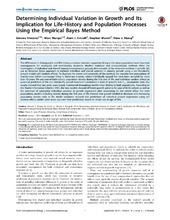| dc.rights.license | This is an open-access article, free of all copyright, and may be freely reproduced, distributed, transmitted, modified, built upon, or otherwise used by anyone for any lawful purpose. | en_US |
| dc.contributor.author | Vincenzi, Simone | eng |
| dc.contributor.author | Mangel, Marc | eng |
| dc.contributor.author | Crivelli, Alain J. | eng |
| dc.contributor.author | Munch, Stephan | eng |
| dc.contributor.author | Skaug, Hans J. | eng |
| dc.date.accessioned | 2015-03-27T10:34:45Z | |
| dc.date.available | 2015-03-27T10:34:45Z | |
| dc.date.issued | 2014-09-11 | eng |
| dc.Published | 2014, 10(9:e1003928) | en_US |
| dc.identifier.issn | 1553-7358 | en_US |
| dc.identifier.issn | 1553-734X | en_US |
| dc.identifier.uri | https://hdl.handle.net/1956/9682 | |
| dc.description.abstract | The differences in demographic and life-history processes between organisms living in the same population have important consequences for ecological and evolutionary dynamics. Modern statistical and computational methods allow the investigation of individual and shared (among homogeneous groups) determinants of the observed variation in growth. We use an Empirical Bayes approach to estimate individual and shared variation in somatic growth using a von Bertalanffy growth model with random effects. To illustrate the power and generality of the method, we consider two populations of marble trout Salmo marmoratus living in Slovenian streams, where individually tagged fish have been sampled for more than 15 years. We use year-of-birth cohort, population density during the first year of life, and individual random effects as potential predictors of the von Bertalanffy growth function’s parameters k (rate of growth) and L∞ (asymptotic size). Our results showed that size ranks were largely maintained throughout marble trout lifetime in both populations. According to the Akaike Information Criterion (AIC), the best models showed different growth patterns for year-of-birth cohorts as well as the existence of substantial individual variation in growth trajectories after accounting for the cohort effect. For both populations, models including density during the first year of life showed that growth tended to decrease with increasing population density early in life. Model validation showed that predictions of individual growth trajectories using the random-effects model were more accurate than predictions based on mean size-at-age of fish. | en_US |
| dc.language.iso | eng | eng |
| dc.publisher | PLoS | en_US |
| dc.rights | Public Domain | eng |
| dc.rights.uri | http://creativecommons.org/publicdomain/zero/1.0/ | eng |
| dc.title | Determining individual variation in growth and its implication for life-history and population processes using the Empirical Bayes method | en_US |
| dc.type | Peer reviewed | |
| dc.type | Journal article | |
| dc.date.updated | 2015-03-03T15:40:23Z | en_US |
| dc.description.version | publishedVersion | en_US |
| dc.source.articlenumber | e1003828 | |
| dc.identifier.doi | https://doi.org/10.1371/journal.pcbi.1003828 | |
| dc.identifier.cristin | 1198831 | |
| dc.source.journal | PLoS Computational Biology | |
| dc.source.40 | 10 | |
| dc.source.14 | 9 | |
| dc.subject.nsi | VDP::Mathematics and natural scienses: 400::Basic biosciences: 470::Bioinformatics: 475 | en_US |
| dc.subject.nsi | VDP::Mathematics and natural scienses: 400::Zoology and botany: 480::Ecology: 488 | en_US |
| dc.subject.nsi | VDP::Matematikk og naturvitenskap: 400::Basale biofag: 470::Bioinformatikk: 475 | nob |
| dc.subject.nsi | VDP::Matematikk og naturvitenskap: 400::Zoologiske og botaniske fag: 480::Økologi: 488 | nob |

